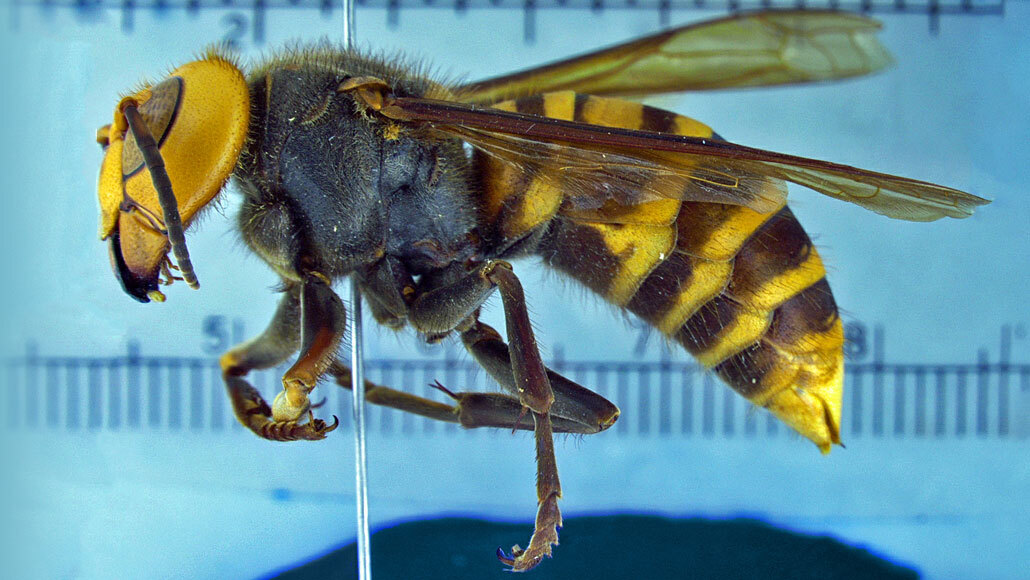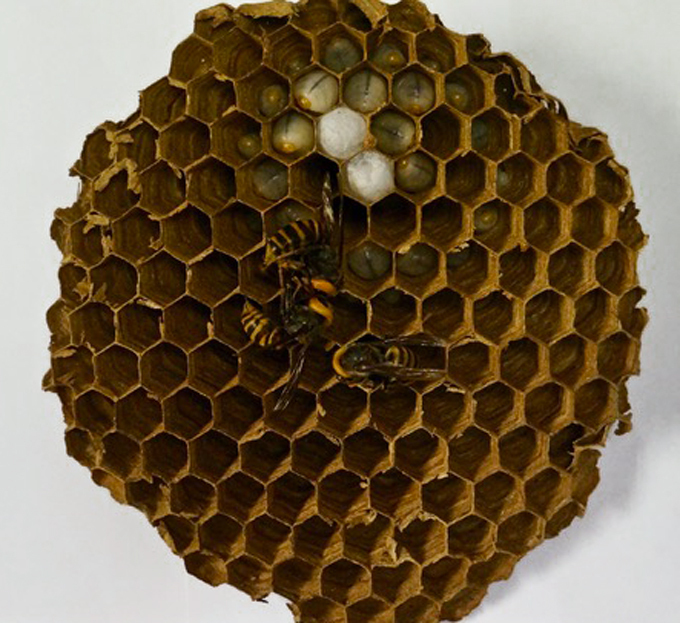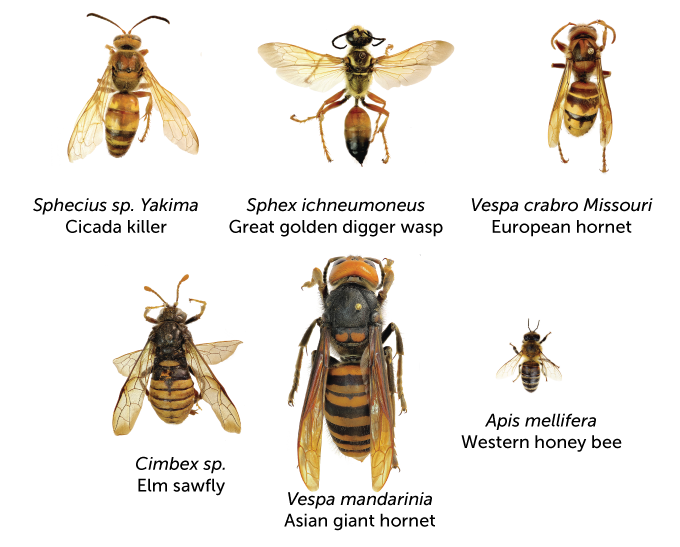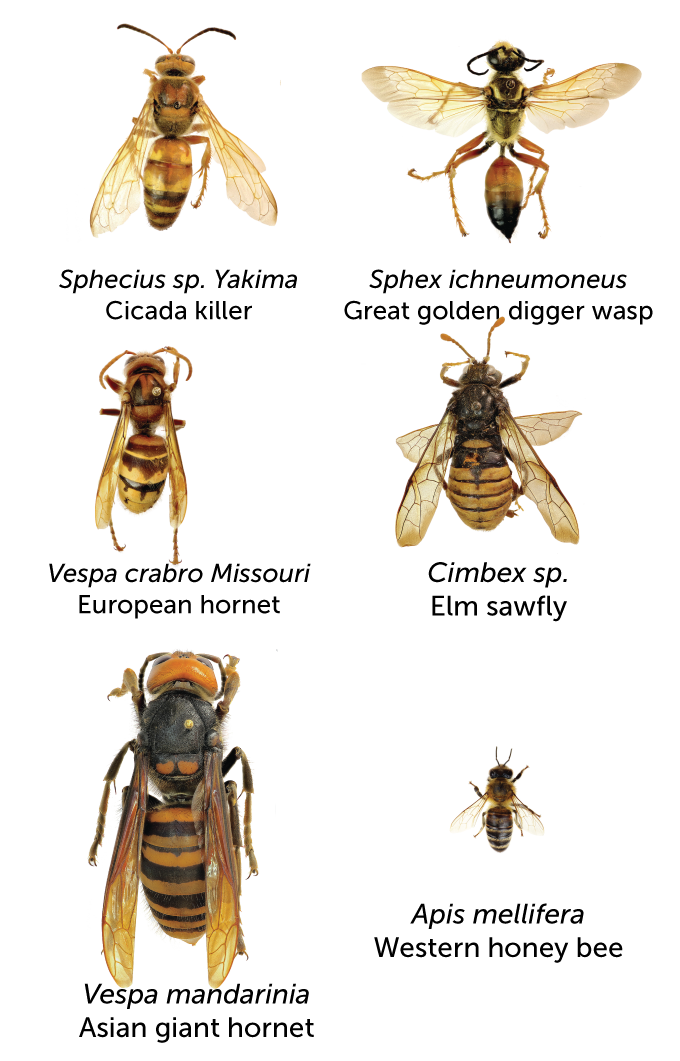
The Asian giant hornet is the world’s largest hornet species, and an invasion of the giants into North America could spell trouble for the honeybees it kills as food for its young.
USDA
Two new specimens of Asian giant hornet have turned up in the Pacific Northwest, suggesting that the invasive species made it through the winter despite efforts last year to stamp out the menace to North America’s honeybees.
A big, yellow-and-black insect found dead in a roadway near Custer, Wash., has been identified as the Asian giant hornet, or Vespa mandarinia, Sven Spichiger, an entomologist at the Washington State Department of Agriculture, announced May 29. It was “probably a queen,” he said, from a brood in a 2019 nest and now ready to found a colony of her own.
Canadian scientists have also confirmed their first giant hornet of 2020, a specimen spotted May 15 in Langley, British Columbia.
Dubbed the “murder hornet” to the annoyance of entomologists, the predator earns its nickname from its proclivity to nab a flying honeybee and carry it home to nourish young hornets. Raiding parties of several dozen Asian giant hornets can kill whole hives containing thousands of bees in a few hours.
Those are just some of the details that make V. mandarinia the newsiest stinging invader in years. It’s a fierce little predator, though not as apocalyptic as “murder hornet” headlines have suggested.
We summarize the week's scientific breakthroughs every Thursday.
Amid the uproar over the “new” hornets, a few facts have been overlooked. For one, North America has previously had at least one close call — not publicized at the time — with the world’s largest hornet. Unlike the current sensational invasion, however, that early episode had a happy ending, at least for the people and native insects of North America. Not so much for the hornets. What’s more, these aren’t the only big, bad hornets that have arrived at the borders of the continent.
Here’s what we know so far, and what we don’t, about Asian giant hornets and the threats they pose.
Is this ‘invasion of the giant hornet’ really new?
Not entirely. What’s new for North America is that last year scientists confirmed Asian giant hornets in the wild.
In September 2019, beekeepers tracked down and destroyed a hornet nest about the diameter of a large grapefruit near a public footpath in Nanaimo near Vancouver, Canada. Lone flying hornets also showed up on both sides of the Canada-U.S. border, one at a hummingbird feeder near Blaine, Wash.
But that wasn’t the Asian giant hornet’s first touchdown on North American soil. California had an overlooked close call in 2016. It wasn’t just some lone hornet hiding in a cargo container, says entomologist Allan Smith-Pardo, now at the U.S. Department of Agriculture’s Animal and Plant Health Inspection Service office in Sacramento, Calif. He was the scientist charged with identifying any suspicious wasps or bees found in cargo or mail nationwide. An inspector flagged an express package coming into the San Francisco airport without any mention of insects in its labeling. Yet it held some kind of papery honeycomb-like nest.

The inspector wondered if someone was smuggling in bees, which U.S. rules strictly ban in order to slow the influx of viruses, predatory mites and other menaces. Smith-Pardo identified the package as something even more dramatic: a whole nest of Asian giant hornets. “There were no adults in the package, but plenty of pupae and larvae,” he says. A few were still alive.
Instead of some bizarre attempt at international sabotage, the package was probably a gourmet treat or even a health aid. In their native home, “collected adults, pupae and larvae are soaked in liquor,” says retired entomologist Jung-Tai Chao, who studied paper wasp social behavior at the University of Georgia as well as hornet ecology at the Taiwan Forestry Research Institute. This “hornet liquor,” he says, is believed to ease arthritis pain.
The 2016 hornet package was opened in a secure room that keeps biological hazards from escaping. So that potential insect disaster became no more than a data point mentioned briefly on page 23 of the May 2020 issue of Insect Systematics and Diversity. The overview looked only at hornets intercepted in the United States during one decade, so there could have been other run-ins with giants.
Is the Asian giant hornet the first hornet to try invading North America?
Far from it.
The hefty, though not record-setting, hornet V. crabro spread from Europe into New York state around the mid-19th century. Now found in scattered places east of the Rockies, the European hornets nest in hollow trees and cozy nooks within walls. Humans who blunder too close can get painful stings, says Bob Jacobson, a retired entomologist in Cincinnati with a long-standing interest in hornets and venoms. His cousin was stung by the species.
Like the Asian giant hornet, the earlier invader attacks honeybees, and Jacobson has seen it go after bumblebees, too, as well as yellow jackets and some other wasps. Unlike the new invader, though, a V. crabro hornet hunts alone. It picks off a bee on a flower or at a hive but doesn’t gang up in groups for mass slaughter of whole insect colonies.
Other hornets have also turned up in North America without stirring public interest. That data search of interceptions in the United States between 2010 and 2018 showed that inspectors stopped four other species besides the giant. In Canada, just in 2019, entomologists identified two different invasive hornet species, including V. soror, which is almost as big as the Asian giant. Whether those arrivals could make a permanent home remains to be seen.
Let’s back up. What are hornets, and why do people get so spooked by them?
True hornets are big, predatory, colony-forming wasps, in the Vespa genus. Apart from V. crabro, found in both Europe and Asia, and one other transcontinental species, hornets are native to Asia. They need meat to feed their young, unlike honeybees, which collect plant pollen for baby food. Another difference: A honeybee dies after its single-use stinger rips out of its body. Hornets, however, are among the insects that can sting and sting again.
The latest hornet identification key lists 22 species: striped and spangled in various browns and rusts, gold and bluish-blacks. North America also has several native wasps popularly nicknamed hornets. These natives, however, belong on a nearby but different twig of the insect evolutionary tree.
Why do Asian giant hornets attack honeybees?
The Asian giant hornet doesn’t really specialize in honeybees, says James Carpenter, a hornet specialist at the American Museum of Natural History in New York City who is now marooned in Australia by travel restrictions. For the early months of the one-year life cycle of a nest in temperate climates, workers forage alone, often for beetles.
Toward the fall, however, the colony’s time is running out, and workers face heavy demands for protein to raise the next generation of queens that will take shelter during the winter and then start their own colonies in spring. Workers band together in unique group-foraging raids. Several dozen attack high-value targets, such as whole nests of honeybees, other species of hornets, and yellow jackets.
The giant hornets “slaughter the adults, then carry back the brood as food for their larvae,” Carpenter says. “Besides the impact on honeybees, then, they might have an impact on native yellow jackets.”
Just how big is the Asian giant hornet, and how could beekeepers fight them?
V. mandarinia ranks as the world’s largest hornet. Queens can grow some 5 centimeters long, about the length of an average-sized woman’s thumb. Wingspans can exceed 7 centimeters, not quite the full width of a woman’s palm. Workers aren’t as big.
Beekeepers in Asia try to turn the giants’ size against them, says entomologist Jeff Pettis in Salisbury, Md., president of Apimondia, an international federation of beekeepers’ associations. He’s seen various kinds of traps and screening devices set up at hive entrances that let a slim honeybee slip through but block big clunking hornets.
Not to be deterred, the hornets will lurk in front of a blocked hive to pick off emerging bees. Pettis has even seen apiary workers with a tennis or badminton racket chasing and “just whacking ’em.”
That’s not at all recommended, by the way. Giant hornets have giant stingers, so it’s better to stay out of their way.


How bad is the sting?
There’s no real relationship between how dangerous and how painful an insect’s sting is, says Justin Schmidt, of the Southwestern Biological Institute and University of Arizona in Tucson.
The Asian giant hornet delivers a big dose of fairly strong venom, he and colleagues determined after testing venom of four kinds of Asian hornets on mice. The giant hornet species could zing the biggest volume into its target, about 1,100 micrograms (dry weight) per individual compared with around 150 from a dainty little honeybee. That hornet venom also has a pretty strong knockdown power. Based on what venom did to lab mice in tests, researchers say that just one full sting would have a 50 percent chance of killing a decent-sized (270-gram) rodent.
The venom of Tetraponera ants from Malaysia has “exquisite lethality,” but the sting isn’t very painful, Schmidt noted in Toxins in 2019. Schmidt has spent decades developing a ranking system for stings by allowing himself to be stung (SN: 7/24/16), Even though he has personal data on more than 80 insects, the Asian giant hornet isn’t one of them. (So far.) From talking to various colleagues who have been stung, however, he estimates that it’s equivalent to three to 10 yellow jackets stinging simultaneously. That’s painful, but “not the end of the world,” he says. What ranks at roughly 10 times more painful in his view are bullet ants.
Pain aside, how dangerous will this hornet be for people?
A much-quoted number from a 2007 paper puts Japan’s death toll for people stung by V. mandarinia at around 30 to 50 people per year. That includes people with allergies to insect venom. (Estimates vary, Jacobson says, but notes a paper reporting 1 percent to 3 percent.) The less-quoted parts of the report from Japan, however, point out that of the 15 people hospitalized for stings and discussed in the paper, those with fewer than 50 stings had a good chance of surviving.
Chao was stung himself while out with his students collecting a large V. mandarinia nest. He’s allergic to stings. “Unfortunately I did not have my antihistamines with me,” he says. He was rushed to a hospital, where after injections and a few hours’ observation, though, he was released.
If this hornet gets established, will people need to stay indoors to survive the invasion?
That’s not the way Paul van Westendorp sees it.
As the principal beekeeping specialist for the province of British Columbia, he received the first Asian giant hornet specimens from beekeepers last year and knows how much damage the hornets can do. Raiding parties literally leave heaps of headless honeybees around a hive during a takeover to steal the young.
To put it in perspective, Asian giant hornets perch at the apex of major insect predators. “Apex predators are maybe very fierce in what they can do, but there are only a few of them around,” he says.
So, for most people the odds of ever coming across one are low. “On a beautiful, hot summer day, one will normally have no hesitation to go for a nice swim in the ocean — even if we recognize that there are orcas out there,” van Westendorp says.







